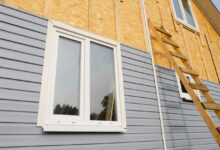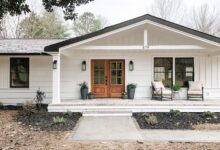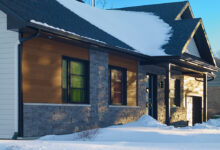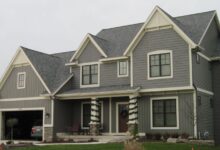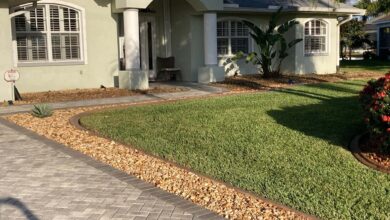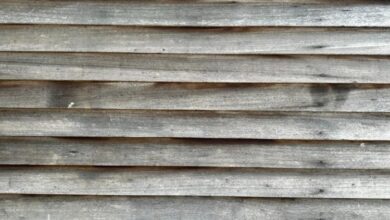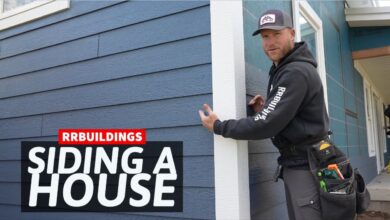Architectural Siding for Luxury Homes
Architectural Siding for Luxury Homes elevates exterior design, transforming residences into stunning showcases of style and sophistication. This exploration delves into the diverse materials, design considerations, installation processes, and long-term implications of choosing the right siding for a luxury property. We’ll examine everything from the aesthetic impact of color and finish to the crucial role of architects and contractors in achieving a seamless, high-end result. Understanding these factors is paramount to creating a home that reflects both individual taste and enduring value.
From the initial selection of premium materials like fiber cement, metal, or wood, to the meticulous installation and ongoing maintenance, we will cover the essential aspects of architectural siding for luxury homes. We will also address the financial considerations, including cost estimates and warranty implications, to provide a comprehensive understanding of this significant investment.
Material Options for Luxury Siding
Choosing the right siding for a luxury home is a crucial decision impacting aesthetics, longevity, and maintenance. The selection process involves careful consideration of various high-end materials, each offering unique advantages and disadvantages. This section details the properties of several premium siding options to aid in informed decision-making.
Fiber Cement Siding
Fiber cement siding, a composite material of cement, cellulose fibers, and sand, offers exceptional durability and longevity. Its resistance to fire, insects, and rot makes it a low-maintenance option ideal for luxury homes. However, it can be more expensive than other materials and requires professional installation due to its weight and susceptibility to cracking if mishandled. The relatively heavy weight may also impact the structural design considerations of the home. Its appearance can mimic wood, stone, or stucco, offering versatility in design.
Metal Siding
Metal siding, typically aluminum or steel, provides superior durability and weather resistance. It’s virtually impervious to rot, insect damage, and fire, requiring minimal maintenance. The lightweight nature of metal siding simplifies installation and reduces stress on the home’s structure. Modern metal siding systems offer a wide range of colors and finishes, including those that mimic the look of wood or stone. However, metal siding can dent or scratch, and it can be susceptible to expansion and contraction in extreme temperatures, leading to potential noise issues. Also, some homeowners find the appearance less aesthetically pleasing than other options.
Stone Veneer Siding
Stone veneer offers unparalleled aesthetic appeal, creating a timeless and luxurious look. Natural stone provides exceptional durability and longevity, requiring minimal maintenance beyond occasional cleaning. However, stone veneer is significantly more expensive than other siding options and requires specialized installation. Its considerable weight necessitates a robust underlying structure. The variations in natural stone’s color and texture can enhance the unique character of a home but also require careful planning to ensure a cohesive design. Depending on the type of stone chosen, it may be more or less susceptible to weathering and staining.
Comparison of Premium Siding Materials
The following table compares three premium siding materials based on cost, durability, and aesthetic appeal. Cost estimates are relative and can vary widely depending on factors such as material type, installation complexity, and regional pricing.
| Material | Cost (Relative) | Durability | Aesthetic Appeal |
|---|---|---|---|
| Fiber Cement | Medium-High | High (50+ years) | High (Versatile) |
| Metal | Medium | Very High (50+ years) | Medium (Modern or Classic) |
| Stone Veneer | High | Very High (100+ years) | Very High (Natural Elegance) |
Design Considerations for Luxury Homes
The selection of architectural siding for a luxury home extends far beyond mere aesthetics; it significantly influences the overall architectural style and the property’s perceived value. Careful consideration of the siding’s impact on the home’s design, its integration with other exterior elements, and the overall visual harmony is crucial for achieving a truly luxurious and cohesive look.
The choice of siding material directly impacts the architectural style of a luxury home. For instance, the clean lines and modern aesthetic of fiber cement siding can complement contemporary architecture, while the rustic charm of natural wood siding is ideal for traditional or Craftsman-style homes. Similarly, the timeless elegance of stone veneer can elevate a home’s grandeur, while stucco offers a versatile option adaptable to various architectural styles. The subtle textural variations and color palettes available in high-end siding options further contribute to the overall architectural expression.
Siding Integration with Other Exterior Elements
Successful exterior design hinges on the seamless integration of all components. The siding should complement, not compete with, other exterior elements such as windows, roofing, and landscaping. For example, the color and texture of the siding should harmonize with the roof’s color and material. Large windows can be beautifully framed by contrasting or complementary siding, enhancing their visual appeal. Landscaping can further enhance the overall aesthetic, with carefully chosen plants and hardscaping that complement the siding’s color and texture. Consider, for instance, a home with cedar shake siding, a dark gray slate roof, and large, multi-paned windows. The natural warmth of the cedar contrasts beautifully with the slate’s cool tones, while the windows allow natural light to accentuate the texture of the siding. Strategic landscaping, incorporating evergreens and carefully placed stone pathways, completes the picture, creating a harmonious and luxurious ensemble.
Visual Description of a Luxury Home
Imagine a sprawling two-story home situated on a gently sloping hill overlooking a tranquil lake. The exterior is clad in wide, horizontal planks of sustainably sourced, naturally weathered gray cedar siding. This siding, with its subtle variations in tone and texture, gives the home a feeling of relaxed sophistication. The large, energy-efficient windows are framed with custom-milled trim that complements the cedar’s natural hues. The roof is a low-pitched gable design covered in dark gray, hand-cut slate tiles. The seamless integration of the siding, roofing, and window frames creates a sense of visual unity. The landscaping features meticulously manicured lawns, interspersed with mature oak trees and strategically placed flowering shrubs, providing a soft, natural contrast to the home’s sharp lines. A stone pathway, constructed from locally sourced granite, meanders from the driveway to the home’s entrance, further enhancing the overall sense of refined elegance. The home’s exterior presents a cohesive and luxurious aesthetic, a testament to the thoughtful integration of premium siding and other design elements.
Installation and Costs
Choosing the right architectural siding for your luxury home is only half the battle; professional installation is crucial to ensuring its longevity, aesthetic appeal, and return on investment. The process is more complex than standard vinyl siding, demanding skilled labor and precise techniques to achieve a flawless, high-end finish. Understanding the installation process and associated costs is vital for budgeting and managing expectations.
The installation of high-end architectural siding involves a meticulous approach, far exceeding the simplicity of basic siding projects. Labor costs represent a significant portion of the overall expense, and the complexity of the material itself directly impacts installation time and therefore, the final price. Different materials require different tools, techniques, and levels of expertise, leading to varying costs. For example, installing fiber cement siding will generally be more expensive than installing high-end vinyl, due to the weight, fragility, and precision required for a seamless finish.
Typical Installation Process for High-End Architectural Siding
The installation of luxury architectural siding is a multi-stage process requiring precision and expertise. A poorly executed installation can compromise the siding’s durability and aesthetic appeal, negating the investment in high-quality materials. Therefore, selecting a reputable and experienced contractor is paramount.
- Preparation: This crucial initial phase involves a thorough assessment of the home’s exterior, including measurements, identification of any underlying issues (like rot or damage), and preparation of the surface for installation. This may include removing old siding, repairing damaged areas, and ensuring a structurally sound substrate.
- Framing and Sheathing: Depending on the existing condition of the house, this step may involve installing new sheathing or reinforcing existing framing to provide a stable and even base for the siding. This is especially important for heavier materials like fiber cement.
- Installation of Underlayment: A water-resistant underlayment is applied to protect the home from moisture intrusion. This layer acts as a barrier, improving the overall performance and longevity of the siding system.
- Siding Installation: This is the core of the process, requiring careful measurement, cutting, and installation of the siding panels. Maintaining consistent alignment and proper overlap is essential for a visually appealing and watertight finish. This step often involves specialized tools and techniques depending on the siding material.
- Finishing Touches: This includes installing trim, flashing, and other accessories to complete the look and ensure proper sealing around windows, doors, and other features. Careful attention to detail is crucial for a high-quality, professional finish.
- Cleanup: A thorough cleanup of the worksite is essential to leave the property in a pristine condition after the installation is complete.
Cost Estimates for Luxury Siding Installation
Accurate cost estimation for luxury siding installation depends on several factors, including the size of the home, the type of siding chosen, the complexity of the project (e.g., intricate detailing, multiple angles), and regional labor costs. These estimates represent a range and should be considered a starting point for budgeting.
| Siding Material | Estimated Cost per Square Foot (USD) | Total Estimated Cost (Large Home, ~3000 sq ft) |
|---|---|---|
| High-End Vinyl Siding | $8 – $15 | $24,000 – $45,000 |
| Fiber Cement Siding | $15 – $30 | $45,000 – $90,000 |
| Metal Siding (Aluminum or Steel) | $18 – $35 | $54,000 – $105,000 |
| Stone Veneer Siding | $30 – $60+ | $90,000 – $180,000+ |
Note: These are estimates and do not include permits, demolition of existing siding, or unforeseen complications. Always obtain multiple quotes from reputable contractors before making a decision.
Sustainability and Environmental Impact
Choosing sustainable siding for a luxury home is not just an ethical consideration; it’s a reflection of sophisticated design and forward-thinking. The environmental impact of building materials extends far beyond the initial construction phase, influencing long-term energy efficiency and the overall carbon footprint of the dwelling. Understanding these implications is crucial for making informed decisions.
The long-term environmental consequences of different siding materials vary significantly. Factors such as material sourcing, manufacturing processes, transportation, lifespan, and end-of-life management all contribute to a material’s overall environmental impact. Materials with lower embodied carbon, reduced reliance on non-renewable resources, and recyclable or biodegradable properties are generally considered more sustainable.
Environmentally Friendly Siding Options
Several siding options offer a compelling blend of aesthetic appeal and environmental responsibility for luxury homes. These materials minimize environmental impact throughout their lifecycle, from sourcing raw materials to disposal. Examples include sustainably harvested wood (certified by organizations like the Forest Stewardship Council), fiber cement (made with recycled materials), and recycled plastic composite siding. Each option presents its own advantages and considerations.
Long-Term Environmental Implications of Siding Materials
The long-term environmental implications are significant and multifaceted. For instance, wood siding, while a renewable resource when sustainably sourced, requires ongoing maintenance to prevent rot and insect infestation. This maintenance involves the use of chemicals that can have environmental consequences. Fiber cement siding, although durable, has a higher embodied carbon footprint during manufacturing than some other options. However, its long lifespan and recyclability can mitigate this over time. Recycled plastic composite siding offers a low embodied carbon footprint, but its durability and longevity may be lower compared to other options, potentially leading to more frequent replacements.
Carbon Footprint Calculation Example
Let’s compare the estimated carbon footprint of two common luxury siding materials: Western Red Cedar (sustainably harvested) and fiber cement. These calculations are simplified estimations and actual values can vary based on specific manufacturing processes, transportation distances, and other factors.
Western Red Cedar (per 100 square feet): Embodied carbon estimated at 500 kg CO2e (This figure is an approximation and varies depending on factors such as transportation distance and forestry management practices. A study by the University of British Columbia, for example, provided a range of embodied carbon for different wood types, with Western Red Cedar falling within this estimate). This includes carbon emissions from harvesting, processing, and transportation.
Fiber Cement (per 100 square feet): Embodied carbon estimated at 800 kg CO2e (This figure is also an approximation and may vary depending on the specific manufacturer and composition of the fiber cement. Studies from organizations such as the Carbon Leadership Forum provide data and methodologies for calculating embodied carbon in building materials). This higher figure reflects the energy-intensive manufacturing process involving cement production.
This example demonstrates that even sustainable options have a carbon footprint, and careful consideration of the entire lifecycle is essential. While Western Red Cedar shows a lower embodied carbon footprint in this simplified example, the long-term maintenance requirements need to be factored into the overall environmental assessment. The higher initial carbon footprint of fiber cement is partially offset by its much longer lifespan, reducing the frequency of replacement and associated carbon emissions.
Color and Finish Options
The selection of color and finish for architectural siding is a crucial design decision impacting a luxury home’s aesthetic appeal and overall market value. Careful consideration of these elements can elevate a property from simply attractive to truly exceptional, reflecting the homeowner’s refined taste and enhancing the home’s curb appeal for years to come. The interplay between color, material, and finish creates a unique visual narrative that speaks volumes about the property’s character.
The impact of color and finish extends beyond mere aesthetics. Certain colors and finishes can significantly influence the perceived value of a home. For instance, a sophisticated, neutral palette often conveys timeless elegance and can command a higher resale price. Conversely, overly trendy or garish choices might limit the appeal to potential buyers in the future. Furthermore, the chosen finish can impact the home’s maintenance requirements and longevity, influencing the long-term cost-effectiveness of the siding. A durable finish can minimize the need for frequent repainting or repairs, resulting in significant savings over the lifespan of the home.
Color Palettes for Luxury Homes
The following presents three sophisticated color schemes suitable for luxury homes, showcasing the versatility of architectural siding across different materials. These palettes emphasize a balance of elegance, modernity, and timelessness. Each scheme incorporates a primary color, an accent color, and a neutral to provide visual interest and cohesion.
- Scheme 1: Warm Modern – This scheme utilizes the warmth of natural materials with a contemporary twist. Imagine a home sided with cedar wood in a rich, medium brown (primary), accented by deep charcoal gray trim (accent) and complemented by a creamy off-white for the window frames and other details (neutral). The natural wood grain of the cedar provides texture and visual interest, while the dark gray and off-white create a refined contrast. This palette evokes a sense of understated luxury and timeless appeal.
- Scheme 2: Cool Coastal – This scheme evokes a sense of calm and serenity. Picture fiber cement siding in a light, cool gray (primary), with accents of a muted, seafoam green (accent) around window casings and entryways. White trim (neutral) further enhances the clean lines and crisp aesthetic. This palette works beautifully for homes near the coast or those seeking a sophisticated, minimalist feel. The cool tones create a feeling of spaciousness and tranquility.
- Scheme 3: Earthy Elegance – This palette draws inspiration from natural earth tones. Visualize a home with stucco siding in a warm, sandy beige (primary) – a classic choice that complements a wide variety of architectural styles. Accents of a deep terracotta or burnt orange (accent) on the roofline or decorative elements add visual warmth and interest. A neutral taupe (neutral) is used for the trim, providing a sophisticated and grounded aesthetic. This scheme provides a feeling of groundedness and timeless sophistication.
Finish Considerations
The finish applied to the siding significantly influences its appearance, durability, and maintenance requirements. Options range from smooth to textured, matte to high-gloss. A matte finish often provides a more understated elegance, while a high-gloss finish can create a dramatic and modern look. The choice depends largely on the desired aesthetic and the overall style of the home. Furthermore, the selected finish should align with the material to optimize performance and longevity. For instance, a smooth finish on fiber cement siding might provide a cleaner, more contemporary look, whereas a textured finish on wood siding might better highlight the natural grain and character of the material.
Maintenance and Repair
Maintaining the pristine appearance and structural integrity of your luxury home’s siding requires a proactive approach. Regular maintenance not only enhances curb appeal but also extends the lifespan of your investment, preventing costly repairs down the line. Different siding materials demand specific care, and understanding these nuances is crucial for preserving your home’s value and beauty.
Routine Maintenance for Different Siding Types
The maintenance requirements vary significantly depending on the siding material. For instance, fiber cement siding, known for its durability, generally requires only occasional cleaning with a soft brush and water to remove dirt and debris. However, more frequent inspections are needed to check for cracks or damage. Vinyl siding, while low-maintenance, can be susceptible to discoloration from mildew and algae, necessitating regular cleaning with a solution of mild detergent and water. Wood siding, being a natural material, demands more attention. It requires periodic cleaning, staining or painting every few years to protect it from the elements and prevent rot. Metal siding, while resistant to many issues, may require occasional spot cleaning to remove rust or stains.
Identifying and Addressing Common Siding Issues
Early detection of siding problems is key to preventing extensive and expensive repairs. Cracks, often caused by impact or settling, should be addressed promptly to prevent water infiltration. Small cracks can sometimes be repaired with caulk, but larger cracks may require professional repair or section replacement. Discoloration, frequently a sign of mildew or algae growth, can usually be remedied with a thorough cleaning using a pressure washer and appropriate cleaning solution. However, persistent discoloration might indicate deeper issues requiring professional attention. Peeling paint on wood siding indicates a need for repainting, while bubbling paint could suggest underlying moisture problems requiring more extensive investigation and repair. Loose or damaged siding panels should be addressed immediately to prevent further damage and maintain the structural integrity of the exterior wall.
Siding Maintenance Checklist
A regular maintenance schedule is crucial for preserving your luxury home’s siding. The following checklist provides a framework for routine inspections and upkeep:
- Annual Inspection: Conduct a thorough visual inspection of all siding surfaces, checking for cracks, damage, discoloration, and loose panels.
- Spring Cleaning: Clean siding with a soft brush and water or a pressure washer (use low pressure to avoid damage). For vinyl or fiber cement, use a mild detergent solution if necessary.
- Fall Inspection: Re-inspect siding after leaf fall, checking for any damage caused by falling branches or debris.
- Bi-Annual (Every 6 months) Cleaning: For wood or areas prone to mildew, more frequent cleaning may be needed.
- Immediate Repair: Address any cracks, loose panels, or other damage immediately to prevent further deterioration.
This checklist provides a general guideline; specific needs will vary based on the siding material, climate, and environmental conditions. Consulting with a professional siding contractor can help establish a tailored maintenance plan for your home.
Trends in Luxury Siding
The luxury siding market is dynamic, constantly evolving to meet the demands of discerning homeowners and architects seeking both aesthetic appeal and superior performance. Current trends reflect a growing emphasis on sustainable materials, innovative designs, and technologies that enhance durability and longevity. This section explores these key developments shaping the future of high-end exterior cladding.
Several factors drive these trends. Increased awareness of environmental impact is pushing the adoption of eco-friendly materials. Technological advancements are continuously improving the performance characteristics of siding, offering enhanced weather resistance, energy efficiency, and low-maintenance properties. Furthermore, a desire for unique architectural expression fuels the exploration of new textures, colors, and installation methods.
Sustainable and Eco-Friendly Materials
The increasing demand for sustainable building practices is significantly influencing the choice of luxury siding materials. Recycled materials, such as reclaimed wood and recycled aluminum, are gaining popularity, appealing to environmentally conscious homeowners. Furthermore, siding made from rapidly renewable resources, like bamboo or fiber cement composed of recycled content, offer a lower environmental footprint compared to traditional options. These materials often boast excellent durability and aesthetic qualities, rivaling—and in some cases exceeding—the performance of conventional siding. For example, a fiber cement siding with a high percentage of recycled content might offer superior resistance to fire, insects, and moisture compared to traditional wood siding, while also reducing the demand on virgin resources.
High-Performance and Technologically Advanced Siding
Technological advancements are leading to the development of high-performance siding materials with enhanced properties. For instance, advanced composite materials incorporating engineered polymers offer superior weather resistance, impact resistance, and low maintenance requirements. These materials often mimic the appearance of natural materials like wood or stone, but with significantly improved durability and longevity. Furthermore, the integration of smart technologies into siding systems is emerging. This could include features like integrated sensors for monitoring environmental conditions or self-cleaning surfaces that reduce the need for regular maintenance. Imagine a siding system that automatically adjusts its insulation properties based on ambient temperature, optimizing energy efficiency throughout the year.
Innovative Design and Architectural Applications
Luxury siding is no longer limited to traditional designs. Contemporary architectural trends are driving the use of innovative shapes, textures, and installation methods. Large-format panels, for example, create a sleek, modern aesthetic, minimizing visible seams and enhancing the visual impact of the building’s facade. The use of varied textures, such as rough-hewn wood-look siding combined with smooth, metallic accents, adds depth and visual interest. Furthermore, the integration of lighting into siding systems can create stunning nighttime effects, adding another layer of sophistication to the design. One innovative example is the use of thin, lightweight metal panels with intricate laser-cut designs, creating unique patterns and shadows on the building’s exterior. These panels can be easily customized to suit any architectural style.
Insurance and Warranty Considerations
Choosing the right architectural siding for your luxury home involves careful consideration of not only aesthetics and durability but also the financial implications, particularly concerning insurance and warranties. Understanding how your siding choice impacts your insurance premiums and the protection offered by manufacturer warranties is crucial for long-term cost-effectiveness and peace of mind.
The type of siding significantly influences your homeowner’s insurance premiums. Materials known for their fire resistance, such as certain types of fiber cement, can lead to lower premiums due to reduced risk. Conversely, siding susceptible to damage from extreme weather events might result in higher premiums. Insurance companies assess risk based on material properties, construction quality, and the overall condition of the home. A detailed appraisal of your home’s exterior, including the siding, is typically part of the insurance assessment process.
The Role of Siding in Home Insurance Policies
Insurance companies consider siding material as a key factor in assessing risk and determining premiums. High-quality, durable siding, like those made from engineered wood or fiber cement, often translates to lower premiums because they are less prone to damage from wind, hail, fire, or impact. Conversely, siding materials that are more vulnerable to these risks may result in higher premiums. The presence of a comprehensive maintenance plan for the siding can also influence the insurer’s assessment. Regular inspections and timely repairs can demonstrate a commitment to minimizing potential risks, potentially leading to favorable premium rates.
The Importance of Warranties and Guarantees
Warranties and guarantees provide crucial protection against manufacturing defects and material failures. For luxury siding, where the investment is substantial, a robust warranty is paramount. A comprehensive warranty should cover defects in materials and workmanship for a specified period, typically ranging from several years to decades, depending on the material and manufacturer. The warranty should clearly outline the scope of coverage, including details on what is covered, how claims are handled, and the process for obtaining repairs or replacements. Before purchasing, carefully review the warranty document to understand its limitations and exclusions. A reputable manufacturer will stand behind its product with a solid warranty.
Sample Warranty Clause for High-End Siding Materials
“This warranty covers defects in materials and workmanship for a period of [Number] years from the date of installation. The manufacturer warrants that the siding will be free from defects in material and workmanship under normal use and conditions. This warranty does not cover damage caused by acts of God, improper installation, vandalism, or neglect. The manufacturer’s liability is limited to the repair or replacement of the defective siding. The manufacturer is not responsible for any consequential damages, including but not limited to labor costs, loss of use, or incidental expenses.”
This is a sample clause and specific terms will vary significantly by manufacturer and product. It’s crucial to carefully read the full warranty document provided by the manufacturer before committing to a purchase. Pay close attention to any limitations or exclusions, and consider the reputation of the manufacturer for honoring its warranty commitments.
Case Studies of Luxury Homes
This section presents three case studies showcasing the successful integration of architectural siding in luxury home designs. Each example highlights different siding materials, color palettes, and architectural styles, illustrating the versatility and aesthetic potential of this building material. The details provided offer valuable insights for homeowners and designers considering similar projects.
Case Study 1: Coastal Modern Residence
This beachfront property in Malibu, California, exemplifies coastal modern architecture. The home features expansive windows and open floor plans, maximizing natural light and ocean views. The exterior siding is primarily composed of wide-plank, sustainably harvested cedar, stained a warm, driftwood gray. This color choice complements the natural surroundings and creates a sense of understated elegance. Vertical siding is used on the main façade, creating a visually striking verticality that emphasizes the home’s height. Large sections of glass are strategically integrated to allow for unobstructed views, while the cedar siding provides a natural, textured contrast. Metal accents, such as dark bronze window frames and a standing-seam metal roof, add a touch of contemporary sophistication.
Case Study 2: Mountain Chalet
Located in the Aspen, Colorado, mountains, this luxury chalet showcases a sophisticated take on traditional mountain architecture. The siding consists primarily of rough-hewn, reclaimed wood, chosen for its rustic charm and inherent durability. The wood, a rich, dark brown with natural variations in color and texture, complements the surrounding alpine landscape. The design incorporates extensive use of stone, seamlessly integrated with the wood siding. The stone provides a strong foundation, while the wood cladding adds warmth and texture. Large overhanging eaves and dormers are characteristic of the chalet style, and the combination of wood and stone creates a sense of both rustic charm and luxurious comfort. Dark brown metal accents are used sparingly, maintaining a cohesive and refined aesthetic.
Case Study 3: Contemporary Farmhouse
This contemporary farmhouse located in the Hudson Valley, New York, blends modern and rustic elements seamlessly. The exterior features a combination of fiber cement siding and reclaimed barn wood. The fiber cement siding, painted a crisp white, provides a clean, modern backdrop. The reclaimed barn wood, used as accents on the gables and around the entryway, adds warmth and character. This combination creates a sophisticated contrast between clean lines and rustic texture. The large windows, a defining feature of contemporary design, allow ample natural light to flood the interior. Black metal accents, such as window frames and light fixtures, add a touch of modern edge, further emphasizing the contrast between the rustic and contemporary elements.
Comparison of Siding Choices
| Case Study | Architectural Style | Primary Siding Material | Color/Finish |
|---|---|---|---|
| Coastal Modern Residence | Coastal Modern | Cedar | Driftwood Gray |
| Mountain Chalet | Mountain Chalet | Reclaimed Wood | Dark Brown |
| Contemporary Farmhouse | Contemporary Farmhouse | Fiber Cement & Reclaimed Barn Wood | White & Natural Wood Tones |
The Role of an Architect and Contractor
Selecting and installing luxury siding is a complex process requiring specialized expertise and careful coordination. The roles of the architect and contractor are distinct yet intertwined, demanding seamless communication and collaboration to achieve the desired aesthetic and functional results for the homeowner. Their combined expertise ensures a successful project, from initial design to final installation.
The architect’s primary responsibility lies in the design phase. They work closely with the homeowner to understand their vision, budget, and lifestyle needs, translating these into detailed architectural plans that specify the type of siding, its integration with other design elements, and overall aesthetic impact. The architect’s involvement extends to selecting appropriate materials, ensuring compliance with building codes and regulations, and providing oversight throughout the construction process. They are responsible for the overall design vision and ensuring its successful implementation. The contractor, on the other hand, is responsible for the practical execution of the architect’s plans. This includes sourcing materials, managing the installation crew, overseeing the project timeline, and adhering to the budget. Their expertise lies in the technical aspects of construction, ensuring the siding is installed correctly, efficiently, and to the highest standards of quality.
Architect’s Responsibilities in Luxury Siding Selection and Installation
The architect’s role begins with understanding the homeowner’s preferences and translating them into a cohesive design. This involves researching and presenting various siding options, considering factors like material properties, durability, maintenance requirements, and aesthetic appeal. The architect creates detailed specifications for the siding, including dimensions, fastening methods, and integration with other building systems. They also review and approve contractor selections, ensuring the chosen contractor possesses the necessary experience and expertise for luxury siding installations. Throughout the project, the architect provides regular oversight, ensuring the installation adheres to the design specifications and building codes.
Contractor’s Responsibilities in Luxury Siding Selection and Installation
The contractor’s responsibilities are primarily focused on the practical aspects of the project. This begins with providing accurate cost estimates based on the architect’s specifications. They are responsible for procuring the necessary materials, managing the installation team, ensuring compliance with safety regulations, and maintaining a clean and organized worksite. The contractor oversees the entire installation process, from initial preparation to final cleanup, and ensures the quality of workmanship meets the highest standards. They also manage any unforeseen issues or challenges that may arise during the installation process, providing timely solutions and updates to the homeowner and architect.
Communication and Collaboration
Effective communication and collaboration between the homeowner, architect, and contractor are paramount for a successful luxury siding project. Regular meetings, detailed documentation, and open communication channels are essential to ensure everyone is on the same page. This collaborative approach helps prevent misunderstandings, delays, and cost overruns. A well-defined communication plan, outlining reporting frequencies and methods, is vital to maintaining transparency and efficiency. This could involve weekly progress reports, shared online project management tools, or regular site visits.
Choosing a Qualified Architect and Contractor
Selecting a qualified architect and contractor is crucial for the success of a luxury home siding project. Homeowners should conduct thorough research, request references, and review portfolios to assess the experience and expertise of potential candidates. Verifying licenses and insurance is also essential, along with checking for memberships in professional organizations. Detailed interviews should be conducted to discuss project expectations, timelines, and budgeting processes. Choosing professionals with proven experience in luxury home projects and a strong reputation for quality workmanship is paramount. The selection process should prioritize not only technical expertise but also communication skills and collaborative working styles to ensure a smooth and successful project.
Ultimate Conclusion
Ultimately, selecting the right architectural siding for a luxury home is a multifaceted decision that requires careful consideration of aesthetics, durability, sustainability, and cost. By understanding the various material options, design principles, and installation processes, homeowners can confidently create an exterior that is both visually stunning and functionally superior. The result? A luxurious home that stands as a testament to refined taste and enduring quality, a true reflection of its owners’ discerning vision.

